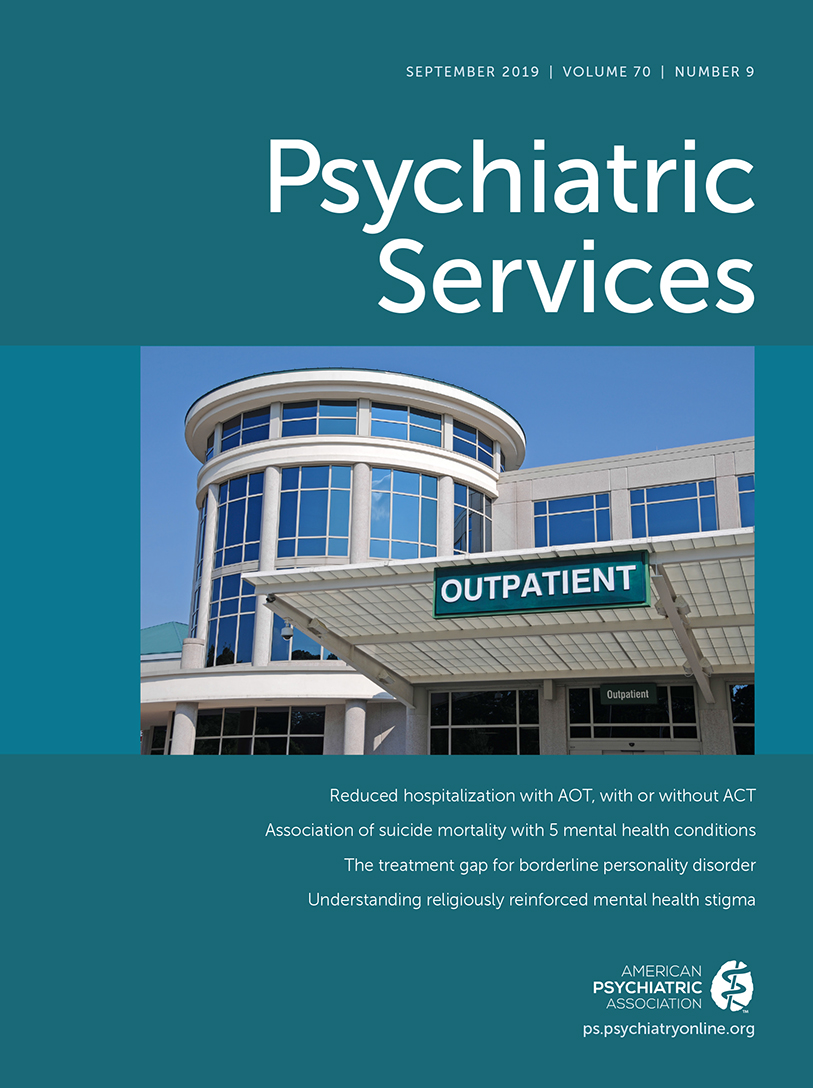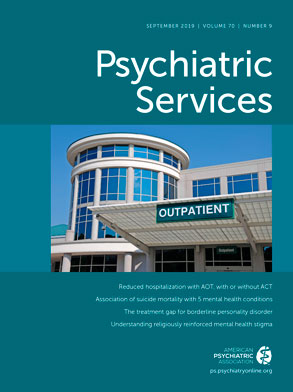Forty-six states and the District of Columbia have laws permitting civil commitment of individuals with mental illness to outpatient care—a practice known as assisted outpatient treatment (AOT). Practitioners are increasingly recognizing AOT as a best practice within a community system of care. The American Psychiatric Association (
1) concluded, “If systematically implemented and resourced, [AOT] can be a useful tool to promote recovery.” In 2016, Congress created an initiative within the Substance Abuse and Mental Health Services Administration to fund and study AOT programs across the United States.
Research shows an AOT program is most effective when it includes “a range of medication management and psychosocial services equivalent in intensity to those provided in assertive community treatment or intensive case management programs” (
1) and when the court order is at least 6 months long (
2–
5). A court order alone is not sufficient for AOT to be effective; yet, it is still unknown what or how intensive the array of treatment services should be (
6).
Assertive community treatment (ACT) teams are the gold standard for intensive community outreach programs (
7). Research indicates ACT is effective in helping frequent utilizers of hospitals live in the community. ACT is widely considered to be the most intensive community-based program serving difficult-to-engage individuals with serious mental illness. For this reason, some jurisdictions have concluded that implementing AOT should be done in conjunction with treatment provided by an ACT team. However, there is no research supporting this assertion. The randomized controlled North Carolina study did not require ACT teams (
3,
5). The New York program under Kendra’s law required a treatment plan that included case management services, typically intensive case management or ACT, while the person was under the court order (
4). Although 20% of individuals received ACT services, the program evaluation did not compare the effect of AOT with or without ACT. As Hiday (
6) stated, “no study has provided the same level of resources and intensity of services as ACT in evaluating assisted outpatient treatment.”
This study is based on data on an AOT program in Sum-mit County (greater Akron), Ohio. The AOT program was developed collaboratively by the county mental health services board, community treatment agencies, and the probate court. The guidelines included clinical criteria to assure that AOT was reserved for those individuals most likely to benefit from court-ordered treatment. Individuals receiving AOT were assigned to the level of care thought to be most congruent with their needs. At the time of the study, the civil commitment statute had a single set of criteria for both inpatient hospitalization and court-ordered outpatient treatment (i.e., AOT), which mandated treatment in the least restrictive alternative, authorized the county mental health services board to monitor adherence to a treatment plan developed by the individual and the treatment agency, and had mechanisms to request a court-ordered evaluation in response to treatment nonadherence and signs of decompensation.
Summit County utilized AOT under this statute for over 2 decades before the commitment law was modified in 2014. One study suggested the use of AOT under this statute was effective in reducing hospital utilization (
8). Most patients on AOT received treatment at a single service-provider agency. During the more than 2 decades of AOT utilization, the agency had one to three ACT teams. Most clients were managed by individual case managers working in teams that included psychiatrists. The agency used a strengths-based case management approach. While no specific service array was offered to clients receiving AOT, all received, at a minimum, case management and psychiatric services. Case managers were required to see clients receiving AOT at least monthly, with assertive outreach an expectation and more frequent contact as clinically indicated. Assessments of individual need determined assignment to an ACT team, residential treatment (i.e., voluntary group home), and/or vocational services. This approach provided us with an opportunity to examine whether patients receiving AOT require an ACT level of service to achieve desired outcomes, including reduced hospital utilization.
Our research question was whether sustained participation in AOT was associated with reduced hospitalizations during and after court-ordered treatment and, if so, whether it was necessary to receive ACT services to experience the reduction in hospitalization.
Methods
We collected data from January 1, 2000, through December 31, 2007. The AOT sample was identified by the mental health services board and consisted of all who had been receiving AOT for at least 6 months from 2000 through 2005. We excluded individuals who were receiving AOT for fewer than 6 months because prior research suggested this length of time was needed to achieve reductions in psychiatric hospitalizations (
3,
9). For the sample of 74 individuals, we examined changes in the number of days of psychiatric hospitalization before, during, and after AOT. All participants had at least 1 year of data prior to AOT (range 371–2,703 days living in the community, i.e., at risk; mean±SD 1,048±534 days). We annualized the number of hospitalizations and hospital days by dividing the total number of hospitalizations and days hospitalized by the number of days at risk before, during, and after AOT and multiplying by 365. We examined the annualized frequency of hospitalizations in the sample by using nonparametric tests.
Results
The sample was 60% (N=44) male and 41% (N=30) female. Most participants (64%, N=47) were white; 37% (N=27) were nonwhite.
Table 1 shows the units of case management services annually for both groups. During the program, clients who received AOT alone received an average of about 10 units of case management service per month (based on annualized data) compared with an average of 24 units for the AOT with ACT group. Using Mann-Whitney mean rankings, we found that, as expected, the ACT group received significantly more case management services than the AOT alone group (p=0.008), but the latter group still received substantial services.
Table 1 also displays the means and standard deviations for hospitalizations before, during, and after AOT (N=74). Wilcoxon signed rank tests indicate a significant decrease in the number of hospitalizations both during and after AOT (p≤0.001 and p=0.002, respectively) and a significant decline in hospital days during and after AOT (p=0.003 and p<0.001, respectively).
Using Mann-Whitney mean rankings, we compared hospitalizations and days hospitalized between the groups that did or did not receive ACT. Those receiving AOT without ACT had significantly fewer mean±SD hospitalizations during the court order (1.1±1.4 vs. 2.3±2.4, p=0.040) and a trend toward fewer hospitalizations after the court order (1.3±2.2 versus 3.4±5.1, p=.056). The group without ACT had significantly fewer days hospitalized after AOT (9 days compared with 23, p=0.006).
Discussion
In a county with AOT and ACT teams available for those thought to need that level of care, sustained participation in AOT was significantly associated with a reduced number of hospital admissions and days in the hospital during and after the program, a finding consistent with existing literature (
2–
5).
The association between AOT and hospitalization was most apparent among those without ACT services, findings consistent with the results of another AOT study (
4). Participating in AOT without ACT was associated with a reduced number of hospitalizations during and a trend toward reduced hospitalizations after AOT. Participating in AOT without ACT was also associated with a reduced number of days hospitalized after the court order ended.
There was an assumption that some individuals under a court order would adhere to treatment and not need the intensity of ACT, while others needed the intensity of ACT to facilitate engagement or because of ongoing need for intensive support. It appears that the treatment team made good triage judgments, given that for those not selected for ACT, the court order coupled with case management and psychiatric services was associated with a sustained reduction in hospital utilization. It should be noted that the AOT group without ACT received considerable clinical services, averaging 10 units of case management services monthly. This group continued with voluntary treatment when the court order ended. It is possible, though not certain, that this was because of AOT participation.
The AOT group that received ACT did not experience the same reductions in hospitalizations or hospital days as the group that did not receive ACT. These individuals were assigned to ACT because they were thought to be more impaired and needed ACT-level care. Close monitoring on ACT may yield a quicker response to increasing symptoms and a corresponding effort to rehospitalize. As access to psychiatric hospitalization has become more difficult in many communities, practitioners have suggested that AOT may serve not only as an intervention to help people remain stable in the community but also as a mechanism to gain quicker access to hospitalization when the need arises (
10).
This study was limited because of a small sample size and a single community. The data are also over 10 years old. The lack of random assignment to ACT was both a limitation and strength. Assignment to ACT was based on clinical determination of need. Although we do not have data to assure that ACT was delivered with fidelity, the treatment agency participated in fidelity reviews and received technical assistance by an ACT Center of Excellence. Additionally, although engagement in voluntary treatment and recovery is the ideal measure of AOT success (
11), our main outcome was rehospitalization. Access to hospitalization may be a positive outcome of AOT if such a level of care is needed. Future research examining the effectiveness of AOT programs should consider the conditions of services engaged (e.g., case load) in addition to degree of service intensity.
Conclusions
This study suggests that AOT can help people with serious mental illness remain in treatment in the community and out of the hospital and that the effects of AOT persist after the court order ends. In this sample, almost two thirds of the patients received standard case management rather than ACT. It does not appear that everyone receiving AOT requires ACT to benefit from court-ordered treatment. That is important, given the lack of availability of ACT services in many communities makes it essential to reserve those services for people with the greatest need. For those who do not need ACT-level services, a court order for treatment combined with case management, psychiatric care, and other supportive services appeared adequate to help them remain in the community. Treatment agencies may be able to triage individuals receiving AOT so that ACT services can be reserved for those determined to have the greatest need for that scarce resource (
12).
Acknowledgments
The authors are grateful for the support of this project from the County of Summit (Ohio) Alcohol, Drug Addiction and Mental Health Services Board and Community Support Services.

